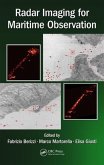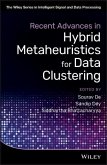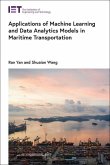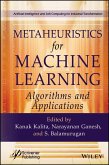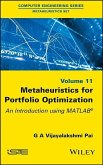- Gebundenes Buch
- Merkliste
- Auf die Merkliste
- Bewerten Bewerten
- Teilen
- Produkt teilen
- Produkterinnerung
- Produkterinnerung
Metaheuristic Algorithms in Maritime Operations Optimization focuses on the seaside and port side problems regarding the maritime transportation. The book reviews and introduces the most important problems regarding the shipping network design, long-term and short-term scheduling and planning problems in both bulk and container shipping as well as liquid maritime transportation. Application of meta heuristic algorithm is important for these problems, as most of them are hard and time-consuming to be solved optimally.
Andere Kunden interessierten sich auch für
![Mathematical Optimization Theory and Operations Research Mathematical Optimization Theory and Operations Research]() Mathematical Optimization Theory and Operations Research37,99 €
Mathematical Optimization Theory and Operations Research37,99 €![A Practical Approach to Metaheuristics Using LabVIEW and Matlab(r) A Practical Approach to Metaheuristics Using LabVIEW and Matlab(r)]() Pedro Ponce-CruzA Practical Approach to Metaheuristics Using LabVIEW and Matlab(r)112,99 €
Pedro Ponce-CruzA Practical Approach to Metaheuristics Using LabVIEW and Matlab(r)112,99 €![Radar Imaging for Maritime Observation Radar Imaging for Maritime Observation]() Fabrizio BerizziRadar Imaging for Maritime Observation296,99 €
Fabrizio BerizziRadar Imaging for Maritime Observation296,99 €![Recent Advances in Hybrid Metaheuristics for Data Clustering Recent Advances in Hybrid Metaheuristics for Data Clustering]() Recent Advances in Hybrid Metaheuristics for Data Clustering165,99 €
Recent Advances in Hybrid Metaheuristics for Data Clustering165,99 €![Applications of Machine Learning and Data Analytics Models in Maritime Transportation Applications of Machine Learning and Data Analytics Models in Maritime Transportation]() Ran YanApplications of Machine Learning and Data Analytics Models in Maritime Transportation147,99 €
Ran YanApplications of Machine Learning and Data Analytics Models in Maritime Transportation147,99 €![Metaheuristics for Machine Learning Metaheuristics for Machine Learning]() Metaheuristics for Machine Learning207,99 €
Metaheuristics for Machine Learning207,99 €![Metaheuristics for Portfolio Optimization Metaheuristics for Portfolio Optimization]() G A Vijayalakshmi PaiMetaheuristics for Portfolio Optimization186,99 €
G A Vijayalakshmi PaiMetaheuristics for Portfolio Optimization186,99 €-
-
-
Metaheuristic Algorithms in Maritime Operations Optimization focuses on the seaside and port side problems regarding the maritime transportation. The book reviews and introduces the most important problems regarding the shipping network design, long-term and short-term scheduling and planning problems in both bulk and container shipping as well as liquid maritime transportation. Application of meta heuristic algorithm is important for these problems, as most of them are hard and time-consuming to be solved optimally.
Hinweis: Dieser Artikel kann nur an eine deutsche Lieferadresse ausgeliefert werden.
Hinweis: Dieser Artikel kann nur an eine deutsche Lieferadresse ausgeliefert werden.
Produktdetails
- Produktdetails
- Verlag: Wiley
- Seitenzahl: 240
- Erscheinungstermin: 19. Juni 2018
- Englisch
- Abmessung: 239mm x 165mm x 18mm
- Gewicht: 476g
- ISBN-13: 9781786302809
- ISBN-10: 1786302802
- Artikelnr.: 51981985
- Verlag: Wiley
- Seitenzahl: 240
- Erscheinungstermin: 19. Juni 2018
- Englisch
- Abmessung: 239mm x 165mm x 18mm
- Gewicht: 476g
- ISBN-13: 9781786302809
- ISBN-10: 1786302802
- Artikelnr.: 51981985
S. Mahdi Homayouni, Laboratory of Artificial Intelligence and Decision Support - INESC TEC, Portugal. Dliala B.M.M. Fontes, IAU, Iran.
Introduction ix
Chapter 1. A Review of Maritime Operations 1
1.1. Maritime transportation 1
1.2. Types of ships and cargo 3
1.3. Containerization 5
1.4. Handling equipment in seaports 8
1.4.1. Quay cranes 10
1.4.2. Vehicles 11
1.4.3. Storage equipment 13
1.5. Optimization of maritime operations 15
1.6. Conclusion 19
Chapter 2. Metaheuristic Algorithms 21
2.1. Basics of metaheuristics 21
2.2. Simulated annealing algorithm 22
2.3. Tabu search algorithm 26
2.4. Genetic algorithms 28
2.5. Particle swarm optimization 32
2.6. Ant colony optimization 34
2.7. Conclusion 37
Chapter 3. Metaheuristics for Ship Operations 39
3.1. Ship routing problem 39
3.1.1. Formulation of the tramp SRP 42
3.1.2. A simple GA for the tramp SRP 46
3.1.3. An ACO for the liner SRP 48
3.2. Green maritime transportations 51
3.2.1. Mathematical formulation of GSRP 54
3.2.2. A PSO for the GSRP 59
3.3. Conclusions 62
Chapter 4. Optimization of Seaside Operations 65
4.1. Berth allocation problem 65
4.1.1. Formulation of the BAP 68
4.1.2. Representation of the BAP solution 70
4.1.3. An SA algorithm for the BAP 72
4.1.4. A bi-objective GA for the BAP 74
4.2. BAP in bulk seaports 76
4.2.1. Formulation of the BAP in bulk seaports 77
4.2.2. SA for the BAP in bulk seaports 80
4.3. Quay crane scheduling problem 82
4.3.1. An MILP for the QCSP 84
4.3.2. Genetic algorithms for the QCSP 87
4.3.3. Tabu search for the QCSP 90
4.3.4. Double cycling QCSP 92
4.4. Integrated berth allocation problem 95
4.4.1. A parallel GA for the B&CAP 98
4.4.2. PSO for the B&CAP 101
4.4.3. A simple hybrid GA for the B&CSP 108
4.5. Conclusions 111
Chapter 5. Problems in Yard Operations 113
5.1. Storage space allocation problem 113
5.1.1. Formulation of the SSAP 116
5.1.2. GA for the SSAP 120
5.2. Yard crane scheduling 124
5.2.1. Mathematical formulation of the YCSP 126
5.2.2. A hybrid TS algorithm for the YCSP 130
5.3. Intra-terminal transportation 135
5.3.1. Formulation of the dispatching of multi-load vehicles 139
5.3.2. A Tabu search for the vehicle routing 142
5.3.3. Formulation of the vehicle scheduling problem 147
5.3.4. GA for the vehicle scheduling problem 150
5.4. Integrated storage space allocation problem 153
5.4.1. A PSO for integrated SSAP-VSP 155
5.4.2. GA for the integrated SSAP-VSP and dispatching of YCs 158
5.5. Integrated scheduling of handling equipment 161
5.5.1. Mathematical formulation of the 3D scheduling 163
5.5.2. SA for the 3D scheduling 172
5.5.3. A GA for the 3D scheduling 176
5.6. Conclusions 179
Conclusion 181
Bibliography 185
Index 207
Chapter 1. A Review of Maritime Operations 1
1.1. Maritime transportation 1
1.2. Types of ships and cargo 3
1.3. Containerization 5
1.4. Handling equipment in seaports 8
1.4.1. Quay cranes 10
1.4.2. Vehicles 11
1.4.3. Storage equipment 13
1.5. Optimization of maritime operations 15
1.6. Conclusion 19
Chapter 2. Metaheuristic Algorithms 21
2.1. Basics of metaheuristics 21
2.2. Simulated annealing algorithm 22
2.3. Tabu search algorithm 26
2.4. Genetic algorithms 28
2.5. Particle swarm optimization 32
2.6. Ant colony optimization 34
2.7. Conclusion 37
Chapter 3. Metaheuristics for Ship Operations 39
3.1. Ship routing problem 39
3.1.1. Formulation of the tramp SRP 42
3.1.2. A simple GA for the tramp SRP 46
3.1.3. An ACO for the liner SRP 48
3.2. Green maritime transportations 51
3.2.1. Mathematical formulation of GSRP 54
3.2.2. A PSO for the GSRP 59
3.3. Conclusions 62
Chapter 4. Optimization of Seaside Operations 65
4.1. Berth allocation problem 65
4.1.1. Formulation of the BAP 68
4.1.2. Representation of the BAP solution 70
4.1.3. An SA algorithm for the BAP 72
4.1.4. A bi-objective GA for the BAP 74
4.2. BAP in bulk seaports 76
4.2.1. Formulation of the BAP in bulk seaports 77
4.2.2. SA for the BAP in bulk seaports 80
4.3. Quay crane scheduling problem 82
4.3.1. An MILP for the QCSP 84
4.3.2. Genetic algorithms for the QCSP 87
4.3.3. Tabu search for the QCSP 90
4.3.4. Double cycling QCSP 92
4.4. Integrated berth allocation problem 95
4.4.1. A parallel GA for the B&CAP 98
4.4.2. PSO for the B&CAP 101
4.4.3. A simple hybrid GA for the B&CSP 108
4.5. Conclusions 111
Chapter 5. Problems in Yard Operations 113
5.1. Storage space allocation problem 113
5.1.1. Formulation of the SSAP 116
5.1.2. GA for the SSAP 120
5.2. Yard crane scheduling 124
5.2.1. Mathematical formulation of the YCSP 126
5.2.2. A hybrid TS algorithm for the YCSP 130
5.3. Intra-terminal transportation 135
5.3.1. Formulation of the dispatching of multi-load vehicles 139
5.3.2. A Tabu search for the vehicle routing 142
5.3.3. Formulation of the vehicle scheduling problem 147
5.3.4. GA for the vehicle scheduling problem 150
5.4. Integrated storage space allocation problem 153
5.4.1. A PSO for integrated SSAP-VSP 155
5.4.2. GA for the integrated SSAP-VSP and dispatching of YCs 158
5.5. Integrated scheduling of handling equipment 161
5.5.1. Mathematical formulation of the 3D scheduling 163
5.5.2. SA for the 3D scheduling 172
5.5.3. A GA for the 3D scheduling 176
5.6. Conclusions 179
Conclusion 181
Bibliography 185
Index 207
Introduction ix
Chapter 1. A Review of Maritime Operations 1
1.1. Maritime transportation 1
1.2. Types of ships and cargo 3
1.3. Containerization 5
1.4. Handling equipment in seaports 8
1.4.1. Quay cranes 10
1.4.2. Vehicles 11
1.4.3. Storage equipment 13
1.5. Optimization of maritime operations 15
1.6. Conclusion 19
Chapter 2. Metaheuristic Algorithms 21
2.1. Basics of metaheuristics 21
2.2. Simulated annealing algorithm 22
2.3. Tabu search algorithm 26
2.4. Genetic algorithms 28
2.5. Particle swarm optimization 32
2.6. Ant colony optimization 34
2.7. Conclusion 37
Chapter 3. Metaheuristics for Ship Operations 39
3.1. Ship routing problem 39
3.1.1. Formulation of the tramp SRP 42
3.1.2. A simple GA for the tramp SRP 46
3.1.3. An ACO for the liner SRP 48
3.2. Green maritime transportations 51
3.2.1. Mathematical formulation of GSRP 54
3.2.2. A PSO for the GSRP 59
3.3. Conclusions 62
Chapter 4. Optimization of Seaside Operations 65
4.1. Berth allocation problem 65
4.1.1. Formulation of the BAP 68
4.1.2. Representation of the BAP solution 70
4.1.3. An SA algorithm for the BAP 72
4.1.4. A bi-objective GA for the BAP 74
4.2. BAP in bulk seaports 76
4.2.1. Formulation of the BAP in bulk seaports 77
4.2.2. SA for the BAP in bulk seaports 80
4.3. Quay crane scheduling problem 82
4.3.1. An MILP for the QCSP 84
4.3.2. Genetic algorithms for the QCSP 87
4.3.3. Tabu search for the QCSP 90
4.3.4. Double cycling QCSP 92
4.4. Integrated berth allocation problem 95
4.4.1. A parallel GA for the B&CAP 98
4.4.2. PSO for the B&CAP 101
4.4.3. A simple hybrid GA for the B&CSP 108
4.5. Conclusions 111
Chapter 5. Problems in Yard Operations 113
5.1. Storage space allocation problem 113
5.1.1. Formulation of the SSAP 116
5.1.2. GA for the SSAP 120
5.2. Yard crane scheduling 124
5.2.1. Mathematical formulation of the YCSP 126
5.2.2. A hybrid TS algorithm for the YCSP 130
5.3. Intra-terminal transportation 135
5.3.1. Formulation of the dispatching of multi-load vehicles 139
5.3.2. A Tabu search for the vehicle routing 142
5.3.3. Formulation of the vehicle scheduling problem 147
5.3.4. GA for the vehicle scheduling problem 150
5.4. Integrated storage space allocation problem 153
5.4.1. A PSO for integrated SSAP-VSP 155
5.4.2. GA for the integrated SSAP-VSP and dispatching of YCs 158
5.5. Integrated scheduling of handling equipment 161
5.5.1. Mathematical formulation of the 3D scheduling 163
5.5.2. SA for the 3D scheduling 172
5.5.3. A GA for the 3D scheduling 176
5.6. Conclusions 179
Conclusion 181
Bibliography 185
Index 207
Chapter 1. A Review of Maritime Operations 1
1.1. Maritime transportation 1
1.2. Types of ships and cargo 3
1.3. Containerization 5
1.4. Handling equipment in seaports 8
1.4.1. Quay cranes 10
1.4.2. Vehicles 11
1.4.3. Storage equipment 13
1.5. Optimization of maritime operations 15
1.6. Conclusion 19
Chapter 2. Metaheuristic Algorithms 21
2.1. Basics of metaheuristics 21
2.2. Simulated annealing algorithm 22
2.3. Tabu search algorithm 26
2.4. Genetic algorithms 28
2.5. Particle swarm optimization 32
2.6. Ant colony optimization 34
2.7. Conclusion 37
Chapter 3. Metaheuristics for Ship Operations 39
3.1. Ship routing problem 39
3.1.1. Formulation of the tramp SRP 42
3.1.2. A simple GA for the tramp SRP 46
3.1.3. An ACO for the liner SRP 48
3.2. Green maritime transportations 51
3.2.1. Mathematical formulation of GSRP 54
3.2.2. A PSO for the GSRP 59
3.3. Conclusions 62
Chapter 4. Optimization of Seaside Operations 65
4.1. Berth allocation problem 65
4.1.1. Formulation of the BAP 68
4.1.2. Representation of the BAP solution 70
4.1.3. An SA algorithm for the BAP 72
4.1.4. A bi-objective GA for the BAP 74
4.2. BAP in bulk seaports 76
4.2.1. Formulation of the BAP in bulk seaports 77
4.2.2. SA for the BAP in bulk seaports 80
4.3. Quay crane scheduling problem 82
4.3.1. An MILP for the QCSP 84
4.3.2. Genetic algorithms for the QCSP 87
4.3.3. Tabu search for the QCSP 90
4.3.4. Double cycling QCSP 92
4.4. Integrated berth allocation problem 95
4.4.1. A parallel GA for the B&CAP 98
4.4.2. PSO for the B&CAP 101
4.4.3. A simple hybrid GA for the B&CSP 108
4.5. Conclusions 111
Chapter 5. Problems in Yard Operations 113
5.1. Storage space allocation problem 113
5.1.1. Formulation of the SSAP 116
5.1.2. GA for the SSAP 120
5.2. Yard crane scheduling 124
5.2.1. Mathematical formulation of the YCSP 126
5.2.2. A hybrid TS algorithm for the YCSP 130
5.3. Intra-terminal transportation 135
5.3.1. Formulation of the dispatching of multi-load vehicles 139
5.3.2. A Tabu search for the vehicle routing 142
5.3.3. Formulation of the vehicle scheduling problem 147
5.3.4. GA for the vehicle scheduling problem 150
5.4. Integrated storage space allocation problem 153
5.4.1. A PSO for integrated SSAP-VSP 155
5.4.2. GA for the integrated SSAP-VSP and dispatching of YCs 158
5.5. Integrated scheduling of handling equipment 161
5.5.1. Mathematical formulation of the 3D scheduling 163
5.5.2. SA for the 3D scheduling 172
5.5.3. A GA for the 3D scheduling 176
5.6. Conclusions 179
Conclusion 181
Bibliography 185
Index 207



